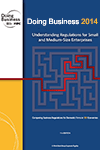Overview
Access to electricity is essential for firms. Yet many entrepreneurs around the world struggle with high costs to connect to electricity grids. In 2013 the cost to connect a single warehouse to a power supply ranged from an average of $19,112 in South Asia to $38,500 in Sub-Saharan Africa. Globally the average was $29,134.
Many studies have focused on the balance between connection costs and tariffs. This case study highlights one way of striking the right balance between costs for new and future connection requests. The getting electricity indicator offers an annual comparison of the procedures, time and cost of obtaining an electricity connection in 189 economies, with data going back to 2009. Of the 3 indicators, costs vary most.
In 2006, Trinidad and Tobago’s Regulated Industries Commission established the Capital Contribution Working Group to review capital contributions for connecting to electricity. Three of the resulting main recommendations implemented were: introducing a reimbursement scheme, setting connection costs with revenue from electricity supply and involving the private sector. The reform allowed for a broader distribution of connection costs in Trinidad and Tobago, and lowered the cost for connecting a standardized warehouse as measured by the getting electricity indicator. Globally policies that have worked well include: having an active regulator, involving stakeholders from the start, learning from other utilities, and clearly communicating about the reform.

